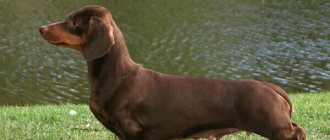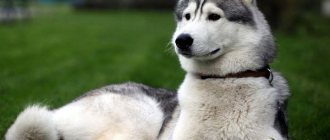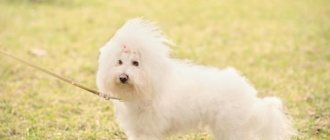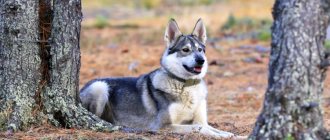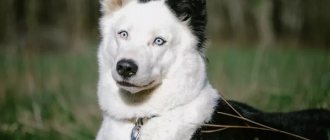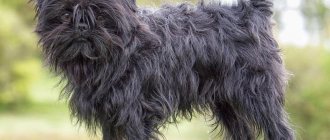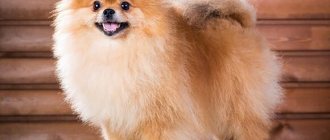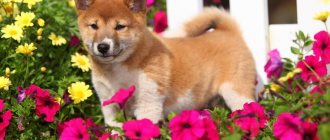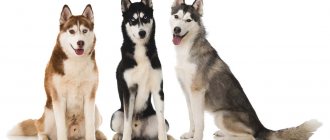Laika is the general name for hunting dog breeds common in the northern forest areas of Asia, Europe and North America. All representatives of this species belong to the Spitz group. The main purpose is game hunting. The animal delays the overtaken beast with a loud, incessant bark. Hence the name of the breed – Laika.
Sled dogs are often included in this group, which include huskies, Samoyeds, Kimmicks, etc. The article presents all breeds of Laikas with photos and names. A brief description of each type separately is also given.
Shepherd huskies
Representatives of this group trace their ancestry back to Nenets Laikas. These are small, light and compact dogs. The height at the withers is about 45 cm for males and 40 cm for females. To protect them from the harsh northern climate, they are given long, warm wool. The skull is wide, the forehead is moderately convex with a clear transition to the muzzle. The muzzle itself is shorter than the skull, the cheekbones are dry, tightly covered with skin. This subgroup is most optimal for shepherd service and is an excellent assistant to shepherds. Despite the fact that the husky is small, it has proven itself excellent in hunting waterfowl, wild birds, squirrels and, surprisingly, bears.
These dogs have a square body, triangular ears, strong paws and brown eyes. This type of husky is endowed with a short fluffy tail, curled into a half ring. The muzzle of such dogs is decorated with whiskers, the chest and neck visually represent a collar with a frill. The front and hind legs have breeches and feathers. The long and dense coat on the lower part of the paws makes them larger, which allows this type of husky to easily move across endless snowy expanses without falling into the snow. A coat of eight centimeters protects dogs from high frosts down to minus fifty degrees, and from forty-degree heat, as well as from annoying gnats and midges. Due to such a thickness of wool, they are not even in danger of being burned when they come into contact with a hot stove.
Shepherd huskies have different colors: black, gray. You can also find representatives of the breed that are brown with splashes of white. This type of huskies has an amazing sense of smell, which allows them to warn shepherds in advance of approaching danger. These dogs are gentle, have a lively and active character, are very sociable, but they show distrust of strangers. Very self-possessed and psychologically stable. They cope well with herding functions and have good hunting skills. Their characteristic qualities include courage, resourcefulness, and balance.
Riding huskies
Dogs that perform draft functions belong to the group of sled huskies. Their height at the withers is about sixty centimeters. This is the largest subgroup, extremely necessary in the north, where there are no roads, and they have to cover huge distances only by dog sleds. This special type of husky has undergone a harsh selection by nature and has developed its outstanding qualities thanks to long-term living in very difficult conditions. As a result of centuries of selection, the coat of such dogs has become dense and hard, with a soft, thick undercoat that prevents the dog from freezing even in the most severe frosts.
Sledable huskies have a stretched body and long paws, which allows them to move freely in deep snow. They are very unpretentious and can easily tolerate periodic and monotonous meals. Their ancestors are considered to be the North Kamchatka dogs and the wild wolf. These dogs are perfectly adapted to local conditions and are capable of transporting not only people, but also large loads over long distances in any weather conditions. As a rule, all types of huskies in this group can make decisions independently in the most extreme situations. There is a lot of evidence of how dogs returned for a musher who had fallen from the sled, dug out people and cargo in snow avalanches, and found the right path during a snowstorm.
West Siberian Laika and its character
will find a faithful assistant in this animal .
Although they resemble a wolf in appearance, their behavior completely disproves any connection with it. West Siberian huskies are balanced creatures that do not show any aggression towards humans. Throughout their lives, they remain very active and energetic, easily getting along with children and other pets. These creatures are very friendly and flexible. They easily establish friendly relations with the owner and members of his family. But sometimes there are specimens that are distinguished by disobedience, trying to demonstrate their stubbornness and perseverance at every opportunity.
The main feature for which Western Siberian Laikas are respected by many owners is their fearlessness. They acquired it thanks to their wonderful past, because their ancestors hunted many large animals, including bears. Laikas are quite understanding, smart and self-confident . Many hunters who have chosen these dogs as their assistants have never been disappointed in their choice. They are easy to raise and train, even at home.
What breeds are sled dogs?
The group of sled huskies includes a variety of breeds. In Chukotka alone they use three types. The Eskimo, Greenland and Kamchatka sled dogs have some differences. Kamchatka specimens are slightly larger; they do not have a pronounced characteristic mask. There are visible light circles under the eyes, making them look like Alaskan Malamutes. In this group, representatives of all breeds of huskies are strong and muscular, which allows them to successfully pull the strap not only in deep snow, but also on strong crust or ice.
The group of sled dogs includes:
- American Indian dog;
- West Siberian Laika;
- Norbotten Spitz;
- Shiba Inu.
All these varieties of sled dog breeds are very strong and hardy, with strong and powerful bones and a very developed chest.
Diseases and life expectancy
The West Siberian Laika has excellent health. He has no genetic or breed diseases. The main pathologies are injuries received while hunting. Also, a dog can catch an infection from a wild animal, so it is necessary to vaccinate it on time. It is especially important to get rabies vaccines, as this disease is fatal. Life expectancy is 16-17 years. Many dogs die early during hunting.
Hunting huskies. Description
Hunting huskies are the most numerous of all hunting dog breeds. This breed is considered universal for hunting and dates back to the times of ancient people, when only the dog was tamed and began to help man hunt other animals. They have a well-developed hunting instinct, excellent sense of smell, excellent hearing and acute vision. They have a quick reaction and can be used for hunting fur-bearing animals - sable, marten, squirrel, mink, ermine. In addition, the hunting husky (its photo is presented in the article) has proven itself excellent in hunting birds and large game - wild boar, elk, bear. Its task is to find the game and bark at it in order to indicate to the hunter its location, as well as to divert attention to itself.
These are nimble, active dogs, they need to work and expend energy. With a lack of physical activity, huskies become sad, which is why they can begin to misbehave: damaging furniture and shoes, making noise, howling.
Let's look at some types of hunting huskies, the most popular and frequently encountered.
Laika - a dog for hunting
All dogs of the Laika breed are distinguished by their sensitive sense of smell and loud bark. This helps them track an animal while hunting and tell a person its location. Hunting dogs are hardy, four-legged human helpers do not lose their sense of smell after many hours of work. They are capable of tracking animals alone, as well as working harmoniously in a team with fellow tribesmen and humans.
Laikas are versatile hunting dogs. The breeds included in this group work successfully in tandem with a hunter, helping to hunt different types of game.
How does a Laika dog behave when hunting?
- waterfowl - tracks a bird by smell, after shooting, takes the prey out of the water and brings it to the hunter;
- small game - tracks, bites the neck without damaging the skin;
- birds (grouse, black grouse, hazel grouse) - sneaking close to the bird, barking informs the owner of its location;
- sable, squirrel - tracks, drives into a tree, does not allow him to go down, barks to call the hunter;
- bear - helps to track, barks, telling the location of the animal, bites the legs, not allowing it to leave.
Important: The main function of a dog is to track game and bark at it. Laika distracts the animal from the hunter and points the person to the location of the game.
Russian-European. Description of representatives
The Russian-European Laika is a dog of medium height (52-58 cm), strong build and lean constitution, agile and lively, with well-developed muscles. She has a wedge-shaped head with a wide skull, the muzzle is shorter than the length of the skull, the transition from the forehead to the muzzle is hardly noticeable, the cheekbones are clearly defined. The eyes are cheerful, oval, with a slight slant, and the ears are triangular and erect. The legs are straight and level, the tail is curled and pressed to the back or thigh. The coat is coarse and thick, long and straight, with a dense soft undercoat. There is a lush collar of wool and scruff on the neck, shoulders and withers. On the hind legs the hair is longer and shaped like pants. Colors include black, piebald, white, red and zonular.
The dog has a very friendly character, is very independent and balanced, it is characterized by agility and playfulness, devotion and loyalty to the owner. It should be washed and bathed only when necessary, since dogs are very clean and tidy.
West Siberian Laika. Description of the appearance of the breed representatives
The West Siberian Laika is similar in height and constitution to the Russian-European Laika. Its height is 54-60 cm. The head has a wedge-shaped structure, the length of the muzzle is almost the same as the width of the skull, and the occipital protuberance is strongly pronounced. The transition from forehead to muzzle is smooth. The ears are elongated triangular, the eyes have an oblique cut. The neck is lean and muscular, the chest is wide and the withers are developed. The belly is tucked in, the tail is crocheted, the paws are straight. Thick hair on the neck, shoulders and withers forms sideburns and a collar. Color black, white, brown, red, zoned. Representatives of this breed are very smart and intelligent, have excellent contact with the owner, but are distinguished by their touchiness.
What does a husky look like?
All representatives of this breed group are unusually beautiful animals with a harmonious build and strong bones, close to the wolf type. The set of exterior parameters, that is, what a Laika dog looks like, depends on the specific variety. However, there are several traits that determine the breed group, which include:
- erect triangular ears;
- wedge-shaped head;
- smooth transition from forehead to muzzle;
- roulette-curled tail;
- straight thick fur of medium length;
- neck collar;
- weakly expressed oblique incision of the eyelids;
- powerful muscular build (at the same time the dog looks slender);
- dry constitution;
- The height at the withers is 1-2 cm greater than at the sacrum.
The height of these dogs is average (a male adult husky has a maximum of 65 cm, females are usually smaller). The color of animals may vary. The most common colors are white-gray, red and mixed.
All representatives of this group of dogs look similar to each other. For example, if you know what the West Siberian type Laika looks like, you can guess that other varieties belong to the same breed. However, these animals are also similar to some sled dogs, such as huskies, which belong to a completely different breed group.
To distinguish the appearance of a husky from what a husky dog looks like, you need to pay attention to the following signs:
- The husky's build is denser; there is a thick layer of fat under the skin. Laikas look thinner.
- Laikas have a fluffier coat.
- Huskies have blue eyes, while huskies usually have brown eyes.
- The tail of a husky is not as tightly curled as that of a husky.
Since at the moment the classification of huskies is quite arbitrary, some sources include huskies, as well as Alaskan Malamute and Samoyed dogs, in this group.
Karelo-Finnish. Description of the breed
Many people do not know the name of the red husky breed. This breed is called Karelian-Finnish because this husky was bred by crossing Karelian and Olonets hunting dogs with Finnish Spitz. This is a very friendly and cheerful dog, bright red and with its muzzle similar to a bear cub. The Karelian-Finnish husky is small in size - only 42-48 cm at the withers, but strong and incredibly agile. Her head is wedge-shaped, the transition from forehead to muzzle is almost imperceptible.
The muzzle is pointed, the ears are oval, small and erect, the eyes are slanted. The withers are well developed, the back is straight and muscular. The paws are straight, the tail is a ring. The coat is straight, hard and very dense with a lush soft undercoat. There are feathers on the hind legs. On the shoulders and neck, the long coat forms a lush, rich collar and stylish sideburns. These cute red huskies (photos of them are presented in the article) have a kind, playful disposition, are very peaceful and friendly, have excellent contact with children, but do not tolerate loneliness well.
Despite her rather modest dimensions, this red-haired beauty has a proud character and is not particularly obedient. Training her will take a long time and painstakingly. But her easy-going nature and cheerful character compensate for these difficulties and make the training process fun for both the dog and its owner. She is very cheerful and charismatic, but at the same time willful. She loves independence and autonomy, is extremely suspicious of strangers and adores her own. She also has an amazing memory.
Breed standard East Siberian Laika
Initially, individuals with a strong type of constitution were considered exemplary. However, modern rules are more loyal to animals with lean muscles. Nevertheless, it is unacceptable to compare two dogs with polar types of condition in the ring. Sexual dimorphism is also inherent in Orientals: the height of a purebred male should be no less than 55 and no more than 64 cm, females should be from 51 to 60 cm.
For VSL workers, the body elongation index is important. In males it ranges from 104-109, in females it ranges from 107-112. It is not difficult to visually determine which dog is more suitable for fishing activities. To do this, it is enough to compare the height of the animal at the withers with the length of the body. If the second value exceeds the first, this is a good sign. Laikas with a stretched body, sufficient height and a strong constitution are more resilient and work easier in snowdrifts. At the same time, too large and too short individuals are considered an unenviable acquisition. The former are harder to climb and with age acquire a loose constitution, the latter quickly get tired and do not work well in heavy snow.
Head
When viewed from above, the skull has a wedge-shaped outline, resembling an equilateral triangle. The brow ridges of the breed are not pronounced, the stop is smooth, the forehead is almost flat. Puppies may have a bulge in the frontal area (growth plate), which levels out by 3-4 years.
As they grow older, the head of the East Siberian husky expands in width due to an increase in muscle mass. The dog's muzzle is rough, normally filled in the area under the eyes, bar-type. There are no signs of wet lips.
Jaws
The jaws are massive and wide with tightly closed incisors. The bite of the premolars is of the wolf type, that is, open. The grip of the jaws is deep and strong.
Eyes
The distinctive features of the eyes of the East Siberian Laika are the oblique cut of the eyelids, almond shape, moderate set (the eyeballs are not protruding, but are not “recessed” deep into the eye sockets). The iris is brown or dark brown, regardless of color.
Ears
The shape of the VSL ear resembles an isosceles triangle with a pointed or slightly rounded apex (ear tip). Standing almost at eye level, in addition, a slight collapse is noticeable when the back edges of the ears are not parallel to each other.
Neck
The necks of East Siberian huskies can be either round or slightly oval in cross-section. The position of the neck in relation to the body is at an angle of 40-50°. The length of the neck corresponds to the length of the head.
Frame
The East Siberian Laika is a strong and moderately pumped up pet. The stretched silhouette characteristic of the breed is ensured by a straight, wide back. In this case, the lumbar region should not be excessively long. The croup is wide, with a moderate slope in the rear. The bottom is tucked, with a slightly pronounced transition from the sternum to the abdomen.
The breed's chest is deep, strong, often falling a couple of centimeters below the elbows or reaching their level. The standard allows oval breasts in cross-section, but does not accept ovoid breasts. An important nuance: for fishing in snowy areas, dogs with an overly developed chest are not the best option, since when the front legs reach out, the wide sternum prevents the shoulder blades from turning outward.
Limbs
The straight and parallel front legs impress with their powerful bones and strength. The shoulders are moderately oblique, the angles of the glenohumeral joints are within 90-100°. The olecranon processes are pronounced, looking backward. The pasterns are short and have a slight slope.
Hind limbs without curvature, parallel to each other. The angles of the joints are clearly marked. The shins are noticeably longer than the thighs, the metatarsals are vertical. The oriental paws gather into a ball, resembling a circle or oval in outline. The presence of dewclaws on the hind legs is unacceptable.
Tail
Crescent-shaped or rolled into a ring-shaped structure. When straightened, the tip is at the level of the hock joints or 1-2 cm shorter.
Wool
The straight spine is characterized by a rigid, rough structure. The undercoat is silky but dense, performing the function of a natural sweatshirt. The hair on the ears and head is short and close. On the neck and shoulders the hair grows more abundantly, turning into a rich collar. At the withers the dog's shoulder is also relatively long.
The legs of the VSL are covered with short, smooth hair, slightly lengthening on their inner part and forming fringes on the hind limbs. The paws of the breed are well furred. This is especially noticeable in the area of the fingers, where the hair comes through with miniature brushes. The dog's tail is protected by straight, hard hair, which is noticeably longer on the inside, but does not extend into dewlap.
Color
Traditional colors of Eastern European huskies: solid black, black and piebald, red, gray and brown of all shades. Black and tan color is also considered valuable, especially if it is a caramel variety (light tan spots on black). Combinations of the listed suits with white are also allowed.
Possible defects
- Deviations from standard height by more than 2 cm.
- The tail is “hook” or “log”.
- Pronounced straightness.
- Marked feet, club feet, twisted elbows.
- Sagging or hunched back.
- The neck has a chin and is much longer than the head.
- Iris of any tone, except those allowed by the standard.
- Heterochromia, bulging or deep-set eyes with a horizontal slitted eyelid.
- Semi-erect or drooping ears set below the eye line.
- A raw, heavy head with an upturned, hook-nosed or sharp muzzle.
Caring for the Karelian-Finnish Laika
When you decide to adopt a Karelian-Finnish Laika into your family, you must understand what kind of care she needs. Her restlessness requires a mandatory long walk. Long hair requires grooming to prevent tangling. This husky sheds twice a year, but apart from combing out the old fur, it does not require any other care. It does not have a sharp specific odor, so it is washed only once or twice a year. She needs her own place, and food should not be near her rookery.
Siberian Laika
The Siberian Laika (pictured below) is a northern beauty. This is a very intelligent hunting dog with well-developed intuition and an exceptional sense of smell. Representatives of the breed are very dexterous and friendly, loyal and faithful. This is one of the breeds that has retained its essence almost in its original form. These dogs are closest to nature and the ancestors from which they originated.
The Siberian is the largest breed of Laika. She was bred in harsh natural conditions. Siberian huskies are divided into two types - East Siberian and West Siberian. The second type has already been mentioned above; now the East Siberian breed should be highlighted.
Compared to its West Siberian relative, the East Siberian Laika has a more elongated format and larger sizes. Its height at the withers averages 55-65 cm, sometimes reaching seventy centimeters. In addition, she has a stronger bone structure and a stronger body. The head is wedge-shaped with a wide skull and a rounded nape. The length of the muzzle and skull are almost the same. The transition to the muzzle is smooth and imperceptible. The ears are triangular, erect, very mobile. The eyes are oval with a moderately oblique slant. Muscular neck and well-developed withers, powerful straight back. The paws of such a dog are straight and muscular. The tail of representatives of the breed is curved in a ring. Very fast and light dogs, easily moving from gait to trot and gallop.
Despite their large size and strong body, these huskies are very active and mobile. Their weight is about 20-25 kg. These powerful animals have a very quiet and calm character. They are not at all aggressive, they are well versed in the terrain, very dexterous, maneuverable and incredibly brave. Thanks to their distinctive qualities, they have proven themselves excellent in hunting. They love to play with a ball or a stick and do not show aggression towards humans.
The dog can serve as a sled dog, pulling children in sleds. She is attentive and fearless - if her owner is in danger, she will do everything to protect him. They have an excellent natural instinct, which helps them to always be on guard and cope well with their security duties.
Description of the breed
The dog is above average in size, with well-developed muscles and a strong skeleton. The height of males is 55-60 cm, females - 51-58 cm, weight from 16 to 22 kg. The head is triangular, the muzzle is long, the skull is not wide. The bitches already have a head. The eyes are almond-shaped (or oval), with an oblique cut, dark brown. The ears are triangular and erect.
The body is strong, somewhat dry, almost square in males, slightly elongated in females. The chest is wide, the stomach is tucked, the back is straight. The legs are straight and muscular, the lower legs are longer than the thighs. The bushy tail lies on the back or side, ring-shaped or sickle-shaped.
Colors and coat
The coat is medium length, thick, the undercoat is soft and dense. The guard hair is straight and hard. The undercoat lifts the guard hair, making the coat visually appear voluminous. There is a beautiful collar on the neck. The color of the dog can be different: a mixture of gray and white, fawn, gray-red and piebald. Black and white coat color is considered a fault.
The West Siberian Laika is similar to the East Siberian Laika. But these breeds have some differences:
| Options | West Siberian Laika | East Siberian Laika |
| Coat color | Gray and white, grey-red, fawn and piebald | Black and tan, black |
| Dimensions | Height up to 60 cm, weight up to 22 kg | Height up to 64 cm, weight up to 23 kg |
| Ears | Acute | Rounded |
| Wool | Middle length | Long |
Both huskies are similar in character; they are excellent hunters and companions.
Character
The West Siberian Laika is loyal and affectionate. She is attentive to her owner’s mood, loves him and obeys him. Since the dog grew up in a pack, it becomes strongly attached to the family. Inhospitable: barks at strangers until the owner calms her down. Even after this, he will be on guard and will not allow himself to be petted.
A hunting dog, it can chase cats and small animals. Ignores large livestock. Does not tolerate closed spaces (begins to bark loudly). She needs freedom to run around. It shows aggression only when hunting towards prey. He can fight with male dogs, thereby finding out who the leader is. Fights with friends over toys or food. Despite the fact that it is an excellent fighter, it cannot be made into a killer or a fighting dog.
The character is balanced, flexible, independent (without stubbornness). Does not tolerate separation from the owner or loneliness well. Loves to run and play. The breed is versatile, hunting small game and large animals. Hardy - can work without getting tired for several days in a row in the taiga. Works independently or together with another dog.
Siberian Laika. Where is the best place to keep and how to care for such a dog?
The East Siberian Laika feels best in a spacious enclosure, but adapts well to life in an apartment. It’s just that the owners should always remember about the incredible activity of the pet and give it the opportunity to frolic for a long time in the open air - run, bark. Thick and long hair will be subject to periodic shedding. Therefore, you will have to comb the dog thoroughly and be prepared for the fact that during this period, pieces of fur will be scattered throughout the house.
Anyone who prefers silence will not be able to be close to a loud and restless husky. It is better if her owner is a hunting enthusiast, then she will periodically show her skills. If you don't like long walks and jogging, don't adopt this breed - it will be a burden for you and a pain for the animal. The East Siberian Laika is very prudent in its diet - it often eats in reserve, which is a very useful property for a hunting dog, which can be on the hunt for several days and does not require feeding.
Samoyed husky. Description of representatives of this species and their character
The Samoyed is also a fairly large dog, covered with thick white hair. It is able to withstand the incredible frosts inherent in the Arctic winter, with strong cold winds. The average height at the withers is fifty to sixty centimeters. Dogs may deviate slightly from the white color and take on a cream color.
The peculiarity of the Samoyed is its smiling mouth. This dog can also be used as a sled dog. Samoyeds are very friendly and affectionate animals. These dogs have a sociable disposition and are committed to family relationships. They get along well with children of different ages. You can keep a dog of this breed in an apartment. But you should provide her with sufficient stress so that she can use up excess energy. They do not tolerate loneliness well, do not like separation, and miss their owners very much when they have to part.
Care and maintenance
West Siberian huskies are almost insensitive to Russian weather conditions. They are not afraid of either severe frosts or hot summer months. The ideal place for a dog of this breed would be a spacious enclosure in the courtyard of a private house. Under no circumstances should you have such a dog in an apartment: it needs a lot of free space to live. In addition, these dogs take a long time and with difficulty to get used to the conditions of a noisy city - this is not why they ran through the Siberian taiga for centuries. Rural areas or urban outskirts are the best places to keep and care for West Siberian huskies.
There are a few things you should have before you bring a dog into your home:
- warm winter booth with soft bedding;
- two large bowls for food and water (preferably metal on a tripod so that the dog does not accidentally turn them over);
- long thick leash 2.5-3 meters;
- muzzle for walking in public places;
- toys, or rather, a lot of toys;
- a collar with a GPS tracker in case of a hunt or if your pet decides to run away from you.
Don't expect to be able to place your husky in a kennel and forget about it. Once a day you will have to change the straw or remove waste, as well as feed and water the dog. You can’t do without walks either: take the animal out to stretch its paws for 1.5-2 hours a day. The entire dog enclosure should be thoroughly cleaned once a month.
How to care for a Samoyed? Peculiarities
Although this breed is very woolly, it is not that difficult to care for. First of all, you need to comb the Samoyed correctly, separating the fur with one hand against the growth of the hair, and with the other, combing the fur in the direction of growth. Do not allow the fur to become tangled, as Samoyeds cannot be cut. When brushing is finished, run the comb against the grain of the hair to lift the undercoat. The dog sheds once or twice a year, and dry shampoo should be used for bathing. Daily walks with intense physical activity are required. Otherwise, such a dog will get bored and may even start acting out (gnawing something or howling).
